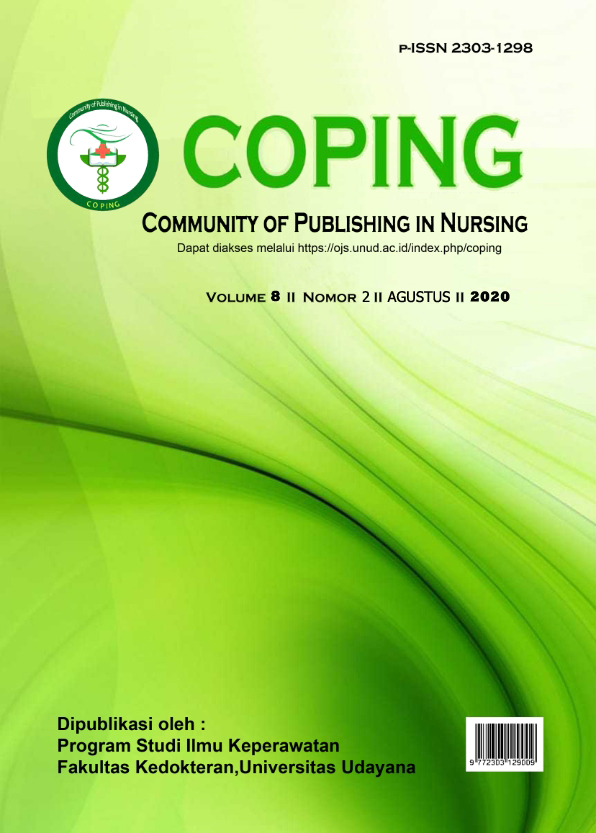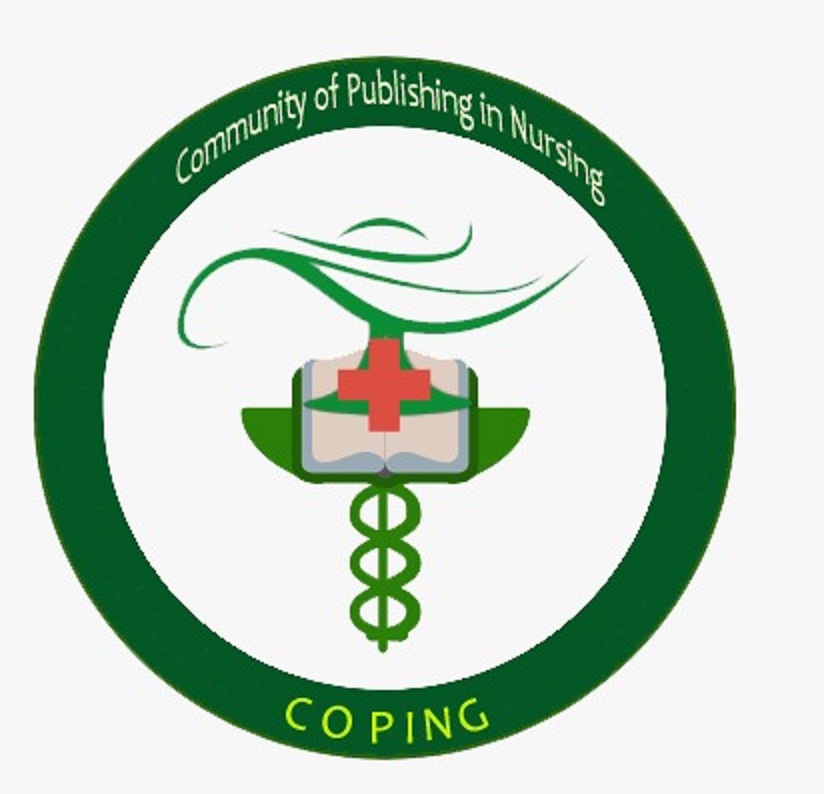GAMBARAN STATUS GIZI SISWA SEKOLAH MENENGAH PERTAMA (SMP) DI KUTA, BALI
Abstract
Adolescents are an aggregate that is prone to experiencing malnutrition or overweight problems. Generally, they do physical activity higher than other aggregates, so they require more nutritional fulfillment. However, the excessive nutrition intake can also occur due to poor eating habits so that the amount of energy input is greater than the expended energy. The aim of this study was to describe the nutritional status of adolescent students. This is a quantitative research with analytic descriptive design using purposive sampling technique on 185 junior high school students in Kuta, Bali. Nutritional status data is obtained by measuring the height of the body using microtoise tool and body weight of the respondents using a mechanical weighing scale. Nutritional status is classified based on the BMI/age z-score table value for children aged 5-18 years from the 2011 Ministry of Health of Indonesia guidelines. The results of data analysis show that the nutritional status category of junior high school students involved as respondents is the majority in the category of normal nutritional status, namely 89 people (48.10%). However, there are still 6 students (3.24%) who have obese status. An efforts were need to be made to maintain the nutritional status of students consistently and in synergy from various parties (parents, schools, and the government).
Downloads
References
Asrar, M., Hadi, H., & Boediman, D. (2009). Pola asuh, pola makan, asupan zat gizi dan hubungannya dengan status gizi anak balita masyarakat Suku Nualu di Kecmatan Amahai Kabupaten Maluku Tengah Provinsi Maluku. Jurnal Gizi Klinik Indonesia, 6(2): 84-94. https://jurnal.ugm.ac.id/jgki/article/view/17716/11497
Dya, N. M. & Adiningsih, S. (2019). Hubungan antara status gizi dengan siklus menstruasi pada siswi MAN 1 Lamongan. Amerta Nutr, 310-314. DOI: 10.2473/amnt.v3i4.2019. 310-314
Fraser, L.K., Clarke, G.P., Cade, J.E., & Edwards, K.L. (2012). Fast food and obesity: A spatial analysis in a large United Kingdom population of children aged 13-15. Am J Prev Med, 42(5):e77-85.
Kementerian Kesehatan RI. (2011). Keputusan Menteri Kesehatan Republik Indonesia. (Direktorat Bina Gizi).
Kementerian Kesehatan RI. (2018). Kenali Masalah Gizi yang Ancam Remaja Indonesia. Diunduh dari https://www.kemkes.go.id/article/view/18051600005/kenali-masalah-gizi-yang-ancam-remaja-indonesia.html
Kurdanti, W., Suryani, I., Syamsiatun, N. H., Siwi, L. P., Adityanti, M. M., Mustikaningsih, D., & Sholihah, K. I. (2015). Faktor-faktor yang mempengaruhi kejadian obesitas pada remaja. Jurnal Gizi Klinik Indonesia, 11(4): 179-190. https://jurnal.ugm.ac.id/jgki/article/view/22900/15594
Lijuan, W., Jing, S., Jian, H., Hong, L., Jin, L. (2016). Iron status of first-year junior high school students in rural boarding school among nine provinces in China. Journal of hygiene research, 45(6) 911-937.
Muhilal, D. D. (2006). Gizi seimbang untuk anak usia sekolah dasar. Jakarta: PT. Primamedia Pustaka.
Noer, E. R., Kustanti, E. R., & Fitriyanti, A. R. (2018). Perilaku gizi dan faktor psikososial remaha obes. Jurnal Gizi Indonesia (The Indonesian Journal of Nutrition), 6(2): 109-113. https://ejournal.undip.ac.id/index.php/jgi/article/view/19130/13588
Nurcahyani, I., Suaib, F., & Istejo, I. (2020). Pengaruh Edukasi Gizi terhadap Peningkatan Asupan Energi dan Protein pada Remaja Putri SMP Al-Ishlah Maros. Ghidza: Jurnal Gizi Dan Kesehatan, 4(1), 100-106. https://doi.org/10.22487/ghidza.v4i1.35
Nuru, H. & Mamang, F. (2015). Association between snacking and obesity in children: a review. International Journal of Community Medicine and Public Health, 2(3): 196-200. DOI: http://dx.doi.org/10.18203/2394-6040.ijcmph20150472
Nuryani & Rahmawati (2018). Kebiasaan jajan berhubungan dengan status gizi siswa anak sekolah di Kabupaten Gorontalo. Jurnal Gizi Indonesia (The Indonesian Journal of Nutrition), 6(2): 114-122. https://ejournal.undip.ac.id/index.php/jgi/article/view/16774/13590
Pakhri.A, Sukmawati, & Nurhasanah. (2018). Pengaruh Edukasi Gizi Terhadap Pengetahuan Gizi Dan Asupan Energi, Protein, Dan Besi Remaja. Media Kesehatan Politeknik Kesehatan Makassar, 13(1), 39–43. https://doi.org/10.32382/medkes.v13i1.97
Patcheep, K. (2011). Factors Influencing Thai Adolescents’ Eating Behaviour. Thesis, School of Nursing Science, Faculty of Medicine and Health Science, University od East Anglia.
Sahputri, D. L. (2015). Hubungan antara ststus gizi dan gambaran tubuh remaja putri di SMA Negeri 3 Cimahi. Skripsi tidak dipublikasikan. Program Studi Ilmu Keperawatan, Fakultas Kedokteran dan Ilmu Kesehatan Universitas Islam Negeri Syarif Hidayatullah. http://www.repository.uinjkt.ac.id/dspace/bitstream/123456789/28934/1/Diza%20Liane%20Sahputri-fkik.pdf.
Sari, F. (2011). Faktor-faktor yang berhubungan dengan terjadinya obesitas pada anak di TK YPI Ibnu Syam, Cempaka Putih dan Waladun Shaleh Kecamatan Banuhampu Kabupaten Agam Tahun 2011. Fakultas Keperawatan, Universitas Andalas, Padang. http://repo.unand.ac.id/id/eprint/165
Sholeha, L. (2014). Hubungan perilaku makan terhadap indeks massa tubuh pada remaja di SMP YMJ Ciputat. Skripsi tidak dipublikasikan. Program Studi Ilmu Keperawatan, Fakultas Kedokteran dan Ilmu Kesehatan Universitas Islam Negeri Syarif Hidayatullah. http://repository.uinjkt.ac.id/dspace/bitstream/123456789/25583/1/LIA%20SHOLEHA-FKIK.pdf
Thamaria, N. (2017). Bahan ajar: Penilaian status gizi. Pusat Pendidikan Sumber Daya Manusia Kesehatan: Badan Pengembangan dan Pemberdayaan Sumber Daya Manusia Kesehatan, Kementerian Kesehatan RI.
Weiss, R., Dziura, J., Burgert, T. S., Tamborlane, W. V, Taksali, S. E., Yeckel, C. W., … Caprio, S. (2004). Obesity and the Metabolic Syndrome in Children and Adolescents. New England Journal of Medicine, 350(23), 2362–2374. https://doi.org/10.1056/NEJMoa031049
Wulandari, NWM, Muniroh, L., Susila, T. Asupan energi dan aktivitas fisik berhubungan dengan z-score IMT/U anak sekolah dasar di daerah perdesaan. Media Gizi Indonesia, 10(1):51-56







